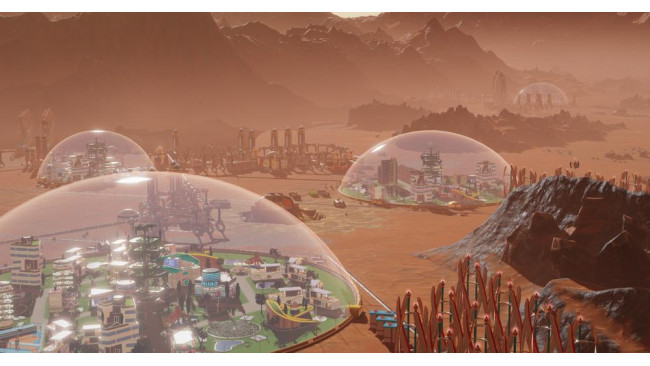
This is a simple quick-start guide to getting your colony self-sufficient as quickly as possible.
Starting Off
This guide aims to not be based on any specific sponsor or commander, however as the information I gather will be based on my own gameplay, it may not be 100% accurate for everyone. Also, I will be ignoring research due to how random it is, and will be simply working with what you get at the start of any run.
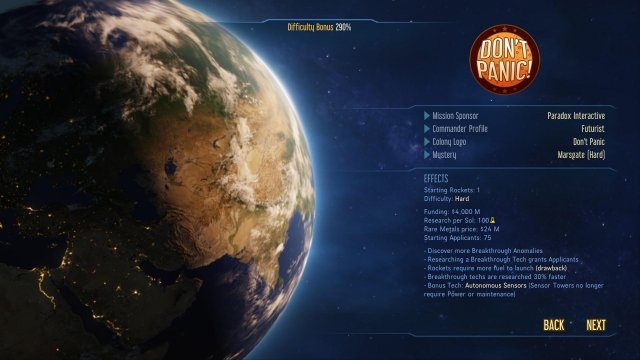
The following is a list of goals we will attempt to accomplish:
- At least one dome housing our Founders, with a sufficient supply and storage of food, water, oxygen and power.
- 1x Fuel Refinery for our rockets and polymer production
- 1x of each factory (polymer, electronics and machine parts) to achieve self-sufficiency
Depending on which sponsor, commander, and location you have chosen (along with a little luck), the difficulty of achieving the last goal can change, which may need you to build an additional dome. Note that for polymers, you only need access to water and the fuel refinery, while electronics require rare metals, and machine parts require metal. It is recommended that you place the last 2 factories in domes close to a deposit of rare metals and regular metals respectively.

For reference, I am currently playing using the following:
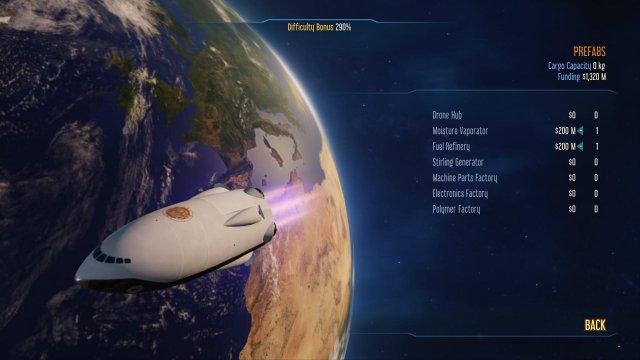
Note that this is currently the hardest difficulty you can obtain just from this screen alone.
Your 1st Rocket (Cargo)
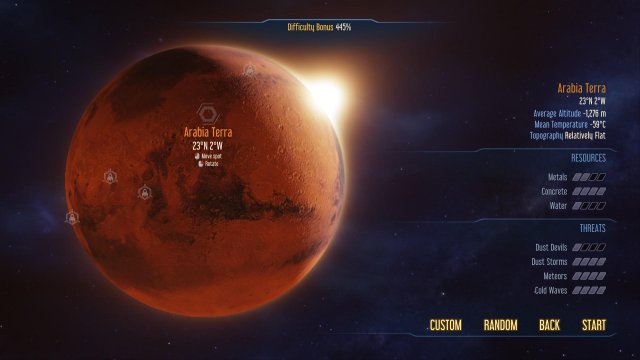
What you put in your 1st rocket is all down to your starting situation and personal preference. Maybe you're rolling in cash and have a warehouse of rockets ready and waiting for you, or maybe you have to scrape by with all the change you can fish out of your meager wallet while bearing the brunt of only having a single rocket available to you. Maybe you want to start building as fast as possible and therefore need all the drones and materials you can get, or maybe you want to be more mobile and explore the expansive part of Mars you've landed in.
Whatever you choose, in order to be self-sufficient as soon as possible, you will at least need the following on your first rocket:
- Fuel Refinery (if your rockets don't regen fuel)
- Machine parts (to build the concrete extractor)
- Drones (to actually build stuff)
- Water Extractor (debatable, however you may start in an area with no water deposits in sight)

During my playthrough, I decided to choose the following to send on my first rocket:
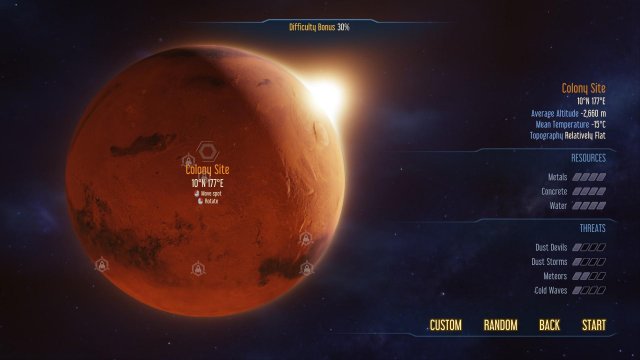
The RC Rover and Transport I can use to help build the things I need for the colony anywhere I want, without being restricted to the area around the rocket. You can use the RC Transport to harvest all the surface metals around you, freeing up the drones to unload the rocket and build the beginnings of your colony.
The RC Explorer is used to help speed up research by analysing the various anomalies littered across the map. While it initially may not sound that important in kickstarting the construction of our colony, keep in mind that you can gain access to researching various helpful techs you otherwise wouldn't have seen until much later due to slow research, or even breakthrough tech that can seriously alter the difficulty of the game for you.
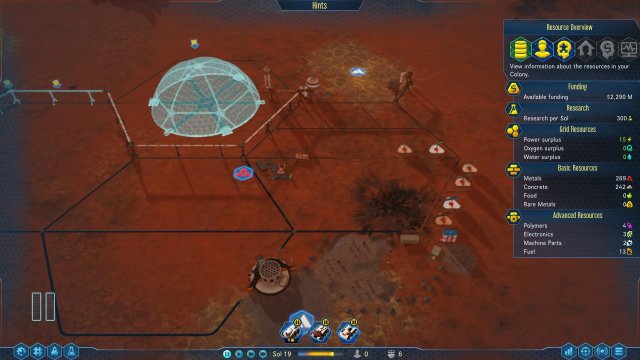
As for the prefab buildings, I will be bringing a fuel refinery and water vaporator, as I will need to quickly refuel the only rocket I've got so I can send it back to Earth ASAP. If you have rockets that can refuel themselves, you don't need the fuel refinery, and if you choose a water rich location you won't need the water vaporator, as both prefabs use 5,000 kg of cargo space that could be used for other things, like more resources.
Lastly, I grab only a tiny supply of 5 polymers, machine parts and electronics each to build the basics of what I need to start off, as well as 4 drones (which will be given to the RC Rover later when the rocket takes off). Please note that you will need to purchase drones especially if you decide to not start with an RC Rover. While an RC Rover does have drones of its own, a rocket typically doesn't unless you actually buy some. A Drone Hub prefab also will not operate until it is actually placed down on the surface of Mars, so please do not make this mistake.
Choosing A Location To Land
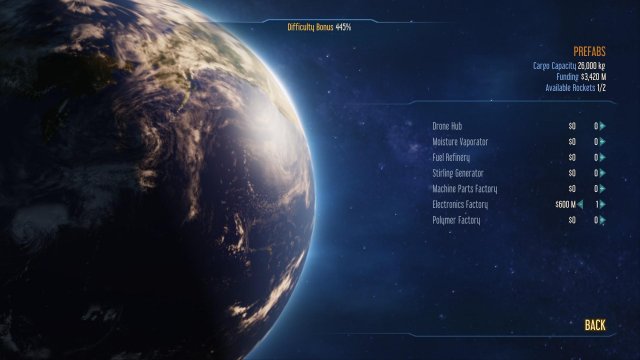
There is a wealth of choices available to you for this, and each person has different preferances. I've decided to use the same map coordinates that Paradox have used in their launch stream.

Note that the Mars has various rocket icons or colony sites available for you to choose from if you are having trouble deciding where to go. These locations typically contain a large abundance of resources, few disasters, and a decently large building area, perfect for people starting out or not wanting too hard of a time. Feel free to choose anywhere on the map however, as you are not restricted to those sites at all, and you even have a random option if you just don't want to choose.
As for the other stats on the right of the screen, besides the name of the landing site and the coordinates, you also have the following:
- Average Altitude: Note that wind turbines have a higher efficiency rating at higher altitudes.
- Mean Temperature: Can help measure how much of the map will be frozen.
- Topography: Can help measure how much of the map is buildable, as well as whether or not the map is separated by cliffs, etc.
- Resources: Displays the availability of metals, concrete and water in the area. The more bars that are filled, the more you will find.
- Threats: These will cause various issues for you colony to survive against. Same as above, the more bars that are filled, the more frequent that threat/disaster will occur.
Dust devils are martian tornados that cause anything hit by it to require immediate maintenance, or can even be destroyed. They can move rather erattically, making predicting where they will move a little hard. They will disappear after a while.
Dust Storms will cause the entire map to be covered in clouds of dust, preventing water vaporators and MOXIES from working, and solar panels will also see a power production reduction. Wind turbines however will see an increase in power production during this time. Due to all the dust, all outdoor facilities will require maintenance faster.
Meteors can be hell on Mars, or blessings in disguise. A warning will show the area a meteor will hit just before impact. Anything within the impact area will be damaged, requiring immediate maintenance, with repeated impacts on the same facility can cause it to become destroyed, at which point it can only be rebuilt or cleared (if you have that tech researched).
Cold waves cause the entire map to freeze over. Any facility in the cold requires more power to continue operating, while water towers will freeze over. There are several facilities that can heat the surrounding area later in the tech trees, but before then, you will simply need to have more power and power storage to get through the cold wave.
Suggested Coordinates:10N177E, 11N177E: Good starting position with max resources and low threat.
First Landing Site & Setup
Your first look at the surface of Mars will reveal to you a single sector on the grid map. This will typically be the first landing site for your rocket, however if you have brought along some Orbital Probes, you can use those to find a different area to land in. Just remember, unless a sector has been scanned, you will not be able to see any of the resources there, including surface metals. The only exception are meteor strikes bringing down new sources of metals or anomalies, as you will be able to see those even in unscanned sectors.
Now that your first rocket has landed on Mars, you can begin setting up the area. Due to the circumstances in my playthrough, I will need to begin refueling my rocket ASAP and send it back to Earth so I can get a second shipment of materials. Having only one rocket hurts...
I use the large solar panels here rather than wind turbines as I don't have a steady supply of machine parts yet, while metals are easily obtained with the help of my RC Transport. While many people are tempted to use wind turbines immediately after getting concrete due to the consistent power generation both day and night, as well as increased productivity at higher elevations and during dust storms, maintenance can get expensive fast.
Instead, I use the concrete to make a power accumulator, so that I can continue powering my base at night after the solar panels have stopped working for the day. Note that each power accumulator has a maximum output of 20 power, while large solar panels have a power generation of 5. What I like doing is building a maximum of 8 solars for every 1 power accumulator or battery I build to maximise the value. The first 4 solars are used to power the base during the day, while the other 4 charge up the battery so that the base has power at night. Please note that I haven't done the exact math on this yet, but it is a good guideline to follow.
The screenshot above shows:
- 6x Large Solar Panels
- 1x Power Accumulator
- 1x Concrete Extractor
- 1x Moisture Vaporator
- 1x Fuel Refinery
- 1x Water Tower
The concrete extractor, moisture vaporator and fuel refinery use 5 power each, so I use 6 solars and 1 battery to ensure they run at all times. The battery is the only thing that uses polymers so I can survive with only a starting amount of 5 polymers, while the concrete extractor and fuel refinery use machine parts for maintenance, hence a slightly higher buffer of machine parts were required for those facilities at 10 machine parts. While you can't see them, I have also built 2 sensor towers around the area to help with scanning the nearby area as fast as possible, and they require an electronic each. Thankfully I have the tech to remove maintenance and power requirements on those sensor towers, so a simple 5 electronics are all that I need here.
Yes, this setup requires a large supply of metals early on, but as mentioned previously, that's exactly what the RC Transport is for, moving across the map mining all the surface metals to bring it back to base. I am also relying heavily on the RC Explorer to help find more techs to research, as well as boosting the rate of research. Early tech reseach can make a huge difference. I'll provide a list of examples from my current playthrough later.
Now that this is all set up, we can now send the next shipments of materials from Earth, this time to build the dome that houses our Founders.
Your 2nd Rocket (Cargo)
Advanced Warning: I realise the following section can get a little confusing, so I'll make a second pass later to put all the relevant data in tables and better formatting to make things clearer to understand. For now, please bear with it!
Now that you have a basic setup, now's a good time to get the second shipment of materials over from Earth to Mars. Based on your sponsor, commander and luck with tech rolls, each person will have a different set of circumstances to deal with, so I will try to be as general as possible.
First, you should see if you have access to a metals or rare metals deposit near where you started. In the case of a metal deposit, you will want to bring a prefab machine parts factory to take advantage of the nearby deposit and start making machine parts on Mars, reducing the need for machine part shipments in the future.
On the other hand if you are near a rare metals deposit, consider buying a prefab electronics factory so that a steady supply of electronics can be secured instead. You don't have to do this however, as you could instead use the rare metals mine to obtain some funding once you ship the rare metals back to Earth. There is always the option to do both, but you may not have enough colonists available to keep both electronics production and rare metal exportation up for any decent amount of time. (ie. Either not much rare metals make it to the factory, or barely any get shipped back to Earth within a decent timeframe).
Finally, if you lack access to a nearby water deposit, purchase some moisture vaporators. Note that each moisture vaporator produces 1 water normally, and can be increased with upgrades or decreased if placed too close together. As for things that use water, the fuel refinery uses 1 water, a basic dome uses 1 water, and hydroponic farms use just slightly under 1 water depending on the crop used. If you have unlocked the farm, the available crops you can choose from range between 1.6 to 2.4 water used. As you would want to also build up a supply of water in water towers in case the moisture vaporators stop working, you would need to produce more water than you would use. Also, if you decide to bring a polymer factory, it also uses 1 water to operate.
Now that you've decided which prefab buildings to send along on your second rocket, we need to use whatever funds you have left to provide enough materials to build the dome your founders are going to live in. If you are bringing a prefab factory along or can already make type of factory due to unlocking the research to do so, try to minimise the amount of resources of that factory's type. As you would be producing the target materials on Mars, there's no need to waste valuable funding and cargo space. Just make sure you bring enough to construct what you need along with any maintenance costs you would need to account for prior to the factory becoming operational (as it won't work until colonists start working in it).
If you don't have access to the farm yet, you will need to bring extra polymers not just for the dome itself, but also for the hydroponics farm. Each hydroponics farm requires 2 polymers to build, while the dome requires 10 polymers. You might also be tempted to build apartments as they house more colonists in the same amount of space, however keep in mind that they also require 10 polymers to build. Power accumulators will also need 2 polymers to build while using 1 polymer for maintenance.
As for machine parts, you will need at least 5 for each metal or rare metal extractor, and 2 for every concrete and water extractor you build. Note that both metal extractors also need 2 machine parts for maintenance, while the water and concrete extractors only need 1 machine part for maintenance. If you decide to bring a polymer factory, those also require a 2 machine part maintenance cost, and if you want to harness wind power, each turbine costs 1 machine part to build, and 0.5 machine parts to maintain.
Lastly we have electronics, which are only really used to build more sensor towers (still not sure on their maintenance costs), maintain the electronics factory with 3 electronics, and maintain the machine parts factory with 2 electronics. If you have a drone hub, each one also requires a maintenance of 1 electronics.
Below is an example of what I decided to stock onto my 2nd rocket, along with a few recommendations. Note that this image was taken much later in my playthrough, and does not fully reflect my funding situation back then, but the contents are relatively accurate, maybe with a little less resources than in reality.
My choice of getting an electronics factory prefab was due to already unlocking the ability to make my own polymer and machine part factories. Having only one rocket that required 80 fuel (originally 100 until I got the Advanced Martian Engines (Engineering) research), it gave me a lot of time to search the map for anomalies to boost my research.
I bring a load of polymers to help build the dome as well as an apartment complex, having obtained the research for it. I've been able to use the surface polymers littered across the map to help supplement the polymers I need for building more power accumulators and maintaining them. Along with a polymer factory I plan on building next to the dome for the colonists to work in, that should cover my polymer needs for the time being.
The machine parts are just as numerous due to the maintenance cost of all the extractors being used at the colony. Even though all I would be spending it on would be the concrete and metal extractors, maintenance costs can stack up to a hefty amount, especially while I wait for my Founders to arrive and settle in to life on Mars. I still haven't started using wind turbines so I don't lose any machine parts there, and luckily I didn't need to build a water extractor, as an anomaly that gave me the choice between $200M, 2 drone hub prefabs, or 4 moisture vaporiser prefabs occurred, so I decided to choose the moisture vaporisers to reduce my reliance on a limited supply of water.
Lastly I only bring 10 electronics as I expect to be producing electronics pretty soon, and they will only really be used for building and maintaining the in-dome factories (machine parts and electronics factories) early on, and then finally drone hubs once I build my 2nd dome. Can't rely on a single RC Rover forever after all, but I can at least try.
As for the food, I decided to use the rest of my funds at the time to provide a small food buffer for my founders once they arrive. I have access to farms already, but this is just in case.
Source: https://gameplay.tips/guides/2177-surviving-mars.html
More Surviving Mars guilds
- All Guilds
- Shuttle Reservation System Users Manual
- - .
- Surviving Mars - Starting Checklist (Tips for Beginners)
- Surviving Mars - Storages (Life Support & Power)
- Surviving Mars - Farm Guide / Best Setups to MinMax Food Production
- Surviving Mars - A Guide to Your First Domes
- Surviving Mars - How to Manage Drones (Easy Way)
- Surviving Mars - Sponsor and Commander Perks List
- Surviving Mars - How to Obtain The Watney Challenge Achievement
